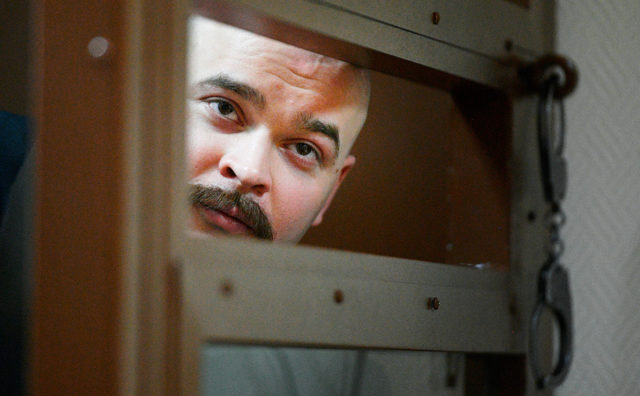
Russian Extreme Nationalists Rally Across Country in Midst of Pandemic
Publication: Eurasia Daily Monitor Volume: 17 Issue: 167
By:

The annual “Russian March”—an attempt by extreme nationalist forces to appropriate Russia’s National Unity Day (November 4)—has routinely provided a suggestive measure of the evolving strength of the radical-right opposition to President Vladimir Putin (see EDM, November 6, 2017 and November 9, 2018). This year turned out to be a particularly salient time in which to take the pulse of Russia’s far-right movement given the ongoing anti-government protests in Khabarovsk (Russian Far East) and in neighboring Belarus, general public dissatisfaction with the Kremlin’s coronavirus response, not to mention the specific challenges of holding a protest in the middle of a pandemic.
Similar to previous years, the biggest marches were attempted in Moscow, although none was given official sanction. First, a new movement headed by Vladimir Potkin (a.k.a. Basmanov) planned to rally under the slogan “Russian Lives Matter” (a clear reference to the Black Lives Matter movement in the United States) and honoring nationalist Maxim “Tesak” Martsinkevich, who died in prison on September 16 (at the age of 36). But with no permission secured from the authorities, Basmanov’s group instead opted to symbolically lay flowers in front of the headquarters of the Moscow Penitentiary Service, on Tsvetnoy Bulvar. Around 2:00 PM, on November 4, some 50 people congregated at the nearby Metro station but were immediately dispersed by police. In the traditional stronghold of the Russian March—the working-class district of Lyublino—a separate march also failed to receive official sanction. Therefore, its organizer, Ivan Beletsky, sought to have socially distanced individuals hold protests along the would-be route of the Russian March, but few showed up after the authorities telegraphed their opposition. A third group, the National Patriotic Forces of Russia (NPSR), also attempted to parade through the streets in honor of Martsinkevich; but in late October, its members were denied a permit. Rather than not hold a march at all, the organizers used the pretext of a religious procession to protest against coronavirus restrictions. Around 250 people demonstrated in front of the Church of the Icon of Our Lady of Kazan, near Komsomolskoye Park. Although the protest featured no speeches, individual marchers willingly spoke to the media about nationalist themes as well as against 5G networks (Sova-center.ru, November 6).
Radical-right sympathizers also held actions in 13 other Russian cities. In St. Petersburg, activists unveiled a banner proclaiming “Russian Lives Matter.” In Barnaul, 50 activists, organized by the regional branch of Eduard Limonov’s The Other Russia, staged a picket facing off against left-wing forces. The far-right demonstrators held up their group’s banners, the Russian imperial flag as well as flags of the Khabarovsk region—a clear, albeit implicit, signal of solidarity with the anti-Kremlin protesters in the Russian Far East. This was the first Russian March in the region since 2013. In Yekaterinburg, three members of a local far-right movement handed out leaflets commemorating the history of the holiday and calling for the restoration of a monument to Russian soldiers who had died in Adler (North Caucasus). In the surrounding Sverdlovsk region, activists also placed pictures of Martsinkevich in their windows. Ivanovo, too, saw its first Russian March–connected demonstrations since 2013: local nationalists unveiled a Russian Lives Matter banner and lit candles. In Kirov, seven activists waving imperial flags laid flowers at the foot of a memorial to soldiers who died in the First World War. In Krasnoyarsk, participants left pictures of Martsinkevich and extreme-right leader Maxim Bazylev (died in prison in 2009) at a monument to victims of political repression. In Kostroma, two individuals unveiled a banner claiming that “the Russian March will not be banned.” In Nizhny Novgorod at least six gathered around a local monument under a Russian imperial flag. In Penza, seven people proceeded to the local monument to victims of political repression and unveiled a Russian Lives Matter banner. In Pskov, having banned a protest action, the authorities sent police to the home of local nationalist organizer Georgy Pavlov to ensure no action took place in the city. Nevertheless, several activists were photographed with Russian Lives Matter banners. In Syktykvar, local organizers held the first sympathetic action to the Russian March since 2015: a group of 25 people gathered under a Russian Lives Matter banner for a congress of right-wing organizations and “movements of the Russian north.” In Sakhalin, several activists participated in a church service and were then photographed beneath an imperial flag (Sova-center.ru, November 5).
While the numbers of participants in the various Russian March events across the country seem tiny, it is important to remember that conditions for organizing protests in Russia currently are exceptionally difficult, and COVID-19 provides the authorities with a useful excuse to ban them. At the same time, this year’s events provide several important takeaways. First, the explicit appropriation of the “Black Lives Matter” slogan shows that Russian far-right nationalists, who view themselves as aggrieved victims, wish to spotlight this perception by casting themselves in ostensibly the same position as African Americans. Second, it is worth pointing out the variety of different issues the protesters raised—including commemorating “political prisoners” linked to their movement, highlighting Imperial Russian historical themes, spreading conspiracy theories about 5G, showing solidarity with demonstrators in Khabarovsk, and the like—all while judicially avoiding more overt political slogans attacking Putin or the government. Third, the creativity of the protesters has itself been noteworthy, similar to the virtual protests that took place against the authorities on April 20, 2020 (Adolf Hitler’s birthday) (Tver24.com, April 20). Indeed, the fact that demonstrations were held at all under the current conditions is remarkable—especially in places where there had been no actions sympathetic to the Russian March for years. As such, extreme nationalism (this time with the late neo-Nazi Maxim Martsinkovich as its symbolic standard-bearer) remains a potent force in Russia.



